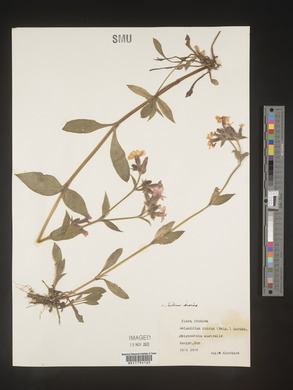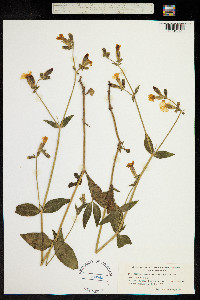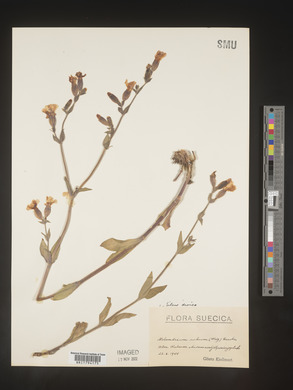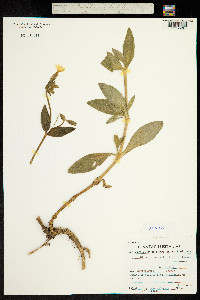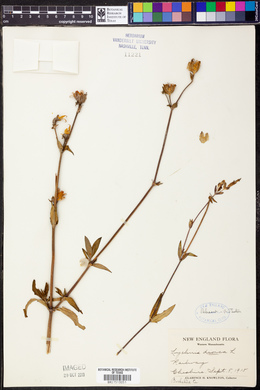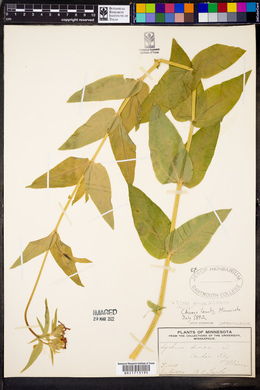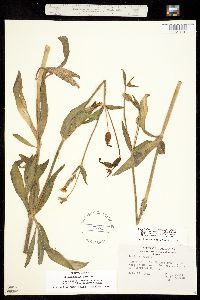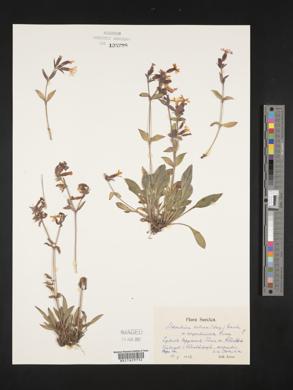Silene dioica
|
|
|
|
Family: Caryophyllaceae
red campion, more...Red Catchfly
[Lychnis dioica L., moreLychnis diurna Sibth., Melandrium dioicum (L.) Coss. & Germ., Melandrium dioicum subsp. rubrum (Weigel) D. Löve, Melandrium diurnum Fr., Melandrium rubrum (Weigel) Garcke, Silene dioica subsp. dioica , Silene diurna Gren. & Godr.] |
Plants perennial; taproot slender. Stems ascending, decumbent at base, branched, shortly rhizomatous, to 80 cm, softly pubescent, ± glandular, at least distally, rarely subglabrous. Leaves sessile at mid and distal stem, petiolate to spatulate proximally; petiole equaling or longer than blade of basal leaves; blade ovate to elliptic, 3-13 cm × 10-50 mm (not including petiole), apex acute to acuminate, sparingly pubescent, densely so on abaxial midrib. Inflorescences dichasial cymes, several- to many-flowered, open, bracteate; bracts lanceolate, 4-20 × 2-7 mm, herbaceous, softly hairy throughout with long-septate hairs, not glandular, or with some glandular hairs. Pedicels ascending, 0.2-3 cm, usually shorter than calyx. Flowers unisexual, some plants having only staminate flowers, others having only pistillate flowers, 20-25 mm diam.; calyx 8-12-veined, campanulate, narrowly so in staminate flowers, broadly in pistillate, 10-15 × to 7 mm in flower, 11 mm broad in fruit, herbaceous, margins dentate, softly pubescent, lobes 5, erect, lanceolate, 2-3 mm; petals bright pink, clawed, claw equaling or longer than calyx, limb spreading horizontally, broadly obovate, unlobed or 2-lobed, to 12 × 12 mm, appendages 4, ca. 1 mm; stamens and stigmas equaling petal claw; styles 5. Capsules broadly ovoid to globose, equaling and often splitting calyx, opening by 5 (splitting into 10) revolute teeth; carpophore absent. Seeds dark brown to black, broadly reniform, plump, 1-1.6 mm, densely and evenly papillate. 2n = 24. Flowering summer. Woodlands, hedges, gardens, riverbanks, open waste places; 0-500 m; introduced; B.C., Man., N.B., Nfld. and Labr. (Nfld.), N.S., Ont., Que.; Conn., Ill., Iowa, Maine, Md., Mass., Mont., N.H., N.J., N.Y., Ohio, Oreg., Pa., R.I., S.Dak., Vt., Wash., Wis.; Europe. Silene dioica is closely related to S. latifolia and completely interfertile with it. The two species hybridize wherever they grow in close proximity, and the offspring (S. ´hampeana Meusel & K. Werner) usually have pale pink flowers. Silene dioica and S. latifolia are difficult to separate in herbarium material unless flower color has been noted. The characters that distinguish S. dioica are the usually dense, long, and soft pubescence covering at least the distal portion of the plant; the broad, almost globose, thin, and brittle capsule with revolute teeth; and the softer, thinner, usually broader leaves. Occasionally, double-flowered plants are encountered as garden escapes.
Perennial herb with a slender taproot to 0.8 m tall Stem: decumbent (at base) to ascending, branched, softly hairy, more or less glandular. Leaves: opposite, upper stalkless, lower stalked to spatula-shaped, 3 - 13 cm long, 1 - 5 cm wide, elliptic to egg-shaped with a pointed tip, sparsely hairy. Inflorescence: a branched, open cluster (dichasial cyme) of several to many flowers, subtended by bracts. Bracts 0.5 - 2 cm long, 2 - 7 mm wide, lance-shaped, and softly hairy. Flowers: male or female (some plants having only one or the other), 2 - 2.5 cm wide, reddish purple or bright pink. Stalk ascending, to 3 cm long, usually shorter than calyx. Stamens ten, equaling petal claw. Styles five, equaling petal claw. The flowers open in the morning. Sepals: fused at the base into a tube (calyx). Calyx tube 1 - 1.5 cm long, to 7 mm wide, bell-shaped, eight- to twelve-veined, softly hairy, with five short lobes. Lobes upright, 2 - 3 mm long, lance-shaped. Petals: five, reddish purple or bright pink, to about 1 cm long and wide, broadly reverse egg-shaped, clawed, two-lobed or unlobed. Fruit: a dehiscent capsule, opening by five (splitting into ten) recurved teeth, equal to calyx, broadly egg-shaped to spherical. Seeds dark brown to reddish black, to 1.6 mm long, broadly kidney-shaped, plump, roughened. Similar species: No information at this time. Flowering: mid-May to late June Habitat and ecology: Introduced from Europe. Rare in the Chicago Region, and known only from a few counties. It has been found along a railroad, roadside, and river bluff. Occurence in the Chicago region: non-native Etymology: Silene probably comes from the Greek word sialon, meaning saliva, referring to the sticky secretion on many of these plants. It may also have come from the word seilenos, referable to Silenus-a foam-covered, drunken character in Greek Mythology. Dioica means "having male and female flowers on separate plants." Author: The Morton Arboretum Much like no. 1 [Silene latifolia Poir.] and hybridizing with it; consistently perennial; stem nearly or quite eglandular; fls red-purple or bright pink, inodorous, opening in the morning; claws hardly auriculate; appendages of the pet 1 mm; fr with recurved teeth; seeds reddish-black, with acute tubercles; 2n=24. Native of Europe, now widespread as an occasional weed in n. U.S. and s. Can. May-Sept. (Lychnis d.; Melandrium d.) Gleason, Henry A. & Cronquist, Arthur J. 1991. Manual of vascular plants of northeastern United States and adjacent Canada. lxxv + 910 pp. ©The New York Botanical Garden. All rights reserved. Used by permission. |




